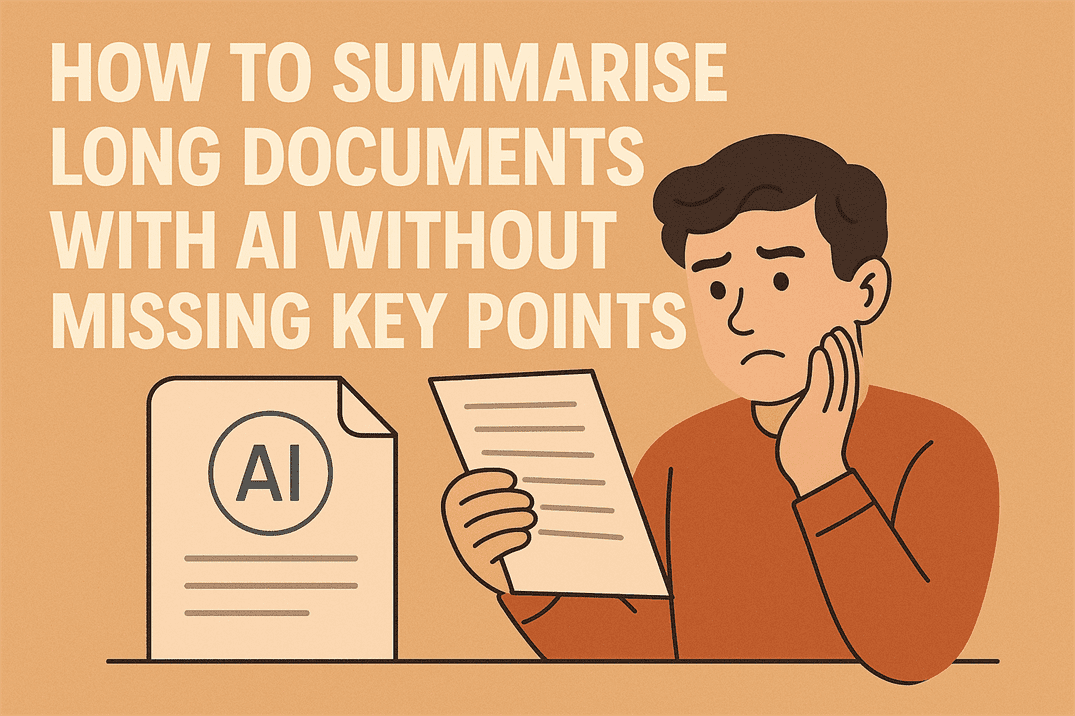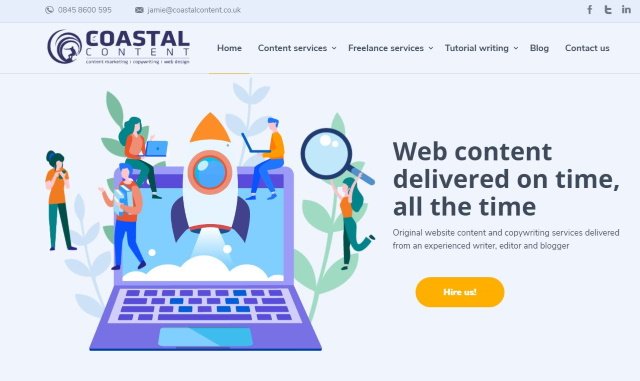How to summarise long documents with AI without missing key points

You know that feeling when you hand an AI a 40-page report and it comes back with a summary so vague it might as well say, “Stuff happened, it was important, carry on”?
Yeah. That’s the danger of oversimplification.
AI is brilliant at compressing text, but if you don’t steer it, it’ll happily flatten nuance, ignore context, and turn your careful argument into the verbal equivalent of a supermarket own-brand soup.
Technically edible, but no one’s coming back for seconds.
The trick isn’t just making summaries shorter. It’s making them shorter without losing the good bits.
Let’s get into how to do that without accidentally deleting the soul of your document.
1. The dangers of oversimplification
AI loves a shortcut. Give it War and Peace, and it’ll return: “Guy goes to war, misses peace.” Which is technically correct but also criminal.
Oversimplification is fine for shopping lists, not so much for business strategies, legal documents, or anything with subtlety.
When the stakes are higher than remembering to buy milk, you need a method that respects nuance.
2. Choosing the right summarisation method
Bullet points or paragraphs? That’s the age-old question. Okay, not age-old, but at least as old as ChatGPT.
- Bullet points: Crisp, scannable, and perfect if you want a quick-and-dirty list of key takeaways. Great for meeting notes or “give me the headlines.”
- Paragraph summaries: Better for when context matters. A narrative flow keeps relationships between ideas intact and prevents that awkward moment where the AI forgets to mention that step three only makes sense if you’ve read step two.
Pick based on your purpose: bullets for speed, paragraphs for meaning. Or mix them like a well-crafted cocktail.
3. Prompt strategies for preserving nuance
Your prompt is your steering wheel. If you just say “summarise this,” don’t be surprised when the car ends up in a ditch.
Instead, try prompts like:
- “Summarise in 5–7 sentences, keeping relationships between ideas clear.”
- “List the top 10 findings but include caveats or uncertainties.”
- “Summarise for someone making a decision, not just skimming.”
Basically, boss the AI around. It likes that.
4. Breaking large documents into sections
Throwing a 100-page PDF at AI in one go is like asking your friend to explain The Lord of the Rings in under a minute.
You’ll get: “There’s a ring. It’s bad. Sorted.”
Split big documents into chapters, sections, or even themes. Summarise those chunks separately, then stitch them together.
You’ll get much more accuracy, fewer omissions and less chance of an AI nervous breakdown.
5. Double-checking for missing data or bias
AI doesn’t know what it doesn’t know. (Yes, I know, so meta.) Which means it might quietly leave out the one thing you actually needed.
Ask follow-up questions:
- “What data points were excluded?”
- “Summarise the counterarguments as well.”
- “Highlight anything uncertain or disputed.”
It’s a bit like grilling a witness in court, politely, but firmly.
6. Pairing AI with human review
Here’s where you come in (or me). AI is the over-eager intern. It drafts quickly, but you still need to check the work.
For casual stuff, fine, let it fly. But for contracts, research papers, or anything with legal implications, always add a human eyeball layer.
Preferably yours. Or a friend’s.
7. Tools for storing and referencing summaries
Summaries are only useful if you can actually find them later. Dumping them in a “random notes” folder is basically a digital black hole.
Options that don’t suck:
- Notion: Great for organising by project, with backlinks so you can find the source material again.
- Obsidian: Markdown nerd heaven, perfect for cross-referencing ideas.
- Evernote (yes, still alive): Old-school, reliable, does the job.
- Google Docs: Boring but functional, especially if you need to share with others.
Pro tip: Always link back to the original doc so you can double check if needed. Future You will thank Present You for the breadcrumbs.
8. Conclusion: Short, accurate, actionable
The best summaries aren’t just shorter. They’re smarter.
They keep nuance, highlight caveats, and give you enough context to make a decision without needing to reread all 80 pages.
So, don’t settle for AI slop. Guide the process, check the output, and store it properly.
Done right, your summaries become a tool you can trust, not a suspiciously vague paragraph that leaves you wondering, “Wait, what did I just miss?”
Now go forth and summarise like the responsible wizard you are. And if your AI tries to tell you War and Peace is “about a war and some peace,” send it back to rewrite, Tolstoy deserves better.
Feeding your AI clean documents
Think of this like cooking, the better your ingredients, the better the meal.
Hand AI a messy document and you’ll get messy soup. Do a little prep work first.
- Use clear headings: Break up sections with H2s/H3s. AI reads them like signposts.
- Delete duplicate content: No need for your “Terms & Conditions” to appear twelve times. AI will obsess over it.
- Fix OCR gremlins: If your PDF was scanned from the 90s, clean up weird line breaks, missing words, and those random “fi” ligatures.
- Keep formatting simple: Tables, weird footnotes, and sidebars can confuse AI. Flatten them or explain them in plain text.
- Label your sections: Add “Part 1 of 5” or “Section: Methodology” so the AI knows what chunk it’s looking at.
- Trim the fluff: Appendices full of unrelated charts? Move them aside unless you actually need them summarised.
Prompt cheat sheet for smarter summaries
Copy, paste, tweak, and watch your AI behave better than usual:
- Balanced overview
“Summarise this document in 5–7 sentences, preserving relationships between ideas and including caveats where relevant.”
- Decision-focused
“Summarise the document as if I need to make a decision based on it. Highlight risks, assumptions, and counterarguments.”
- Bullet style
“List the 10 most important findings as bullet points but include context for why each point matters.”
- Chunking large docs
“Summarise this section only, focusing on key arguments, data, and any limitations. I will repeat this for each section.”
- Bias check
“Summarise the main points, then list perspectives or data that might have been excluded or overlooked.”



